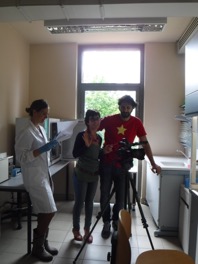A new ecotoxicity test for nanomaterials
The development of nanotechnologies and the increasing use of the nano-sized materials in many products (paints, cosmetics, textiles, etc.) open new concern about their environmental fate and demand for environmental risk assessment. Standard ecotoxicological assays used for chemicals do not seem to be effective in evaluating the toxicity of nanomaterials, hence, there is a growing demand for new methods and tools to assess the potential toxicity of this new generation of contaminants. In particular, it is crucial to identify new approaches to solve the typical problems of nanotoxicology, related to the intrinsic characteristics of nanoparticles, whose physical and chemical features are not comparable with their chemical counterpart. This research is aimed to set up and optimize protocols to evaluate nanomaterial ecotoxicity, particularly in marine environments, as requested by EU Guidelines. A new assay was designed, able to assess the ecotoxicity of both nanomaterials and conventional contaminants, by using a strain of Vibrio anguillarum, a brackish/marine microorganism. This new protocol allows the determination of acute toxicity, as LC50, i.e. the concentration causing 50% decrease in bacterial culturability after 6-hour exposure. The novelty of this protocol, if compared to the other methods using microorganisms is mainly related to the exposure medium, a saline solution, which avoid the well-known interference between growth media and contaminants, able to affect the biological response. Furthermore, it allows to carry out the test on a wide range of salinity, environmental variable able to modify nanoparticle toxicity. This work represents the starting point for the ecotoxicological evaluation of nanoparticles on halotolerant marine organisms. This work is supported by the research program "NanoBioTech Environment and Health", granted by the Regione Lazio/Hypazia Consortium, with a specific project agreement with the National Institute for the environmental Protection (ISPRA). The work is done in collaboration with: the staff of the Hypazia Consortium, in particular Flavio Lucibello, president of the Consortium, the NEXT research group from the National Institute for Nuclear Physics (INFN-LNF), and Loredana Manfra (Ecotoxicology lab, ISPRA). To allow an easier utilization of the protocol in other laboratories, the protocol has been published as a video, too.
Rotini A., Manfra L., Spanu F., Pisapia M., Cicero A.M., Migliore L. (2017) - ECOTOXICOLOGICAL METHOD WITH MARINE BACTERIA VIBRIO ANGUILLARUM TO EVALUATE THE ACUTE TOXICITY OF ENVIRONMENTAL CONTAMINANTS. Journal of Visualized Experiments, 123: e55211. DOI: 10.3791/55211
 |
 |
 |
Bacteria are an important component of the ecosystem, and microbial community alterations can have a significant effect on biogeochemical cycling and food webs. Toxicity testing based on microorganisms are widely used because they are relatively quick, reproducible, cheap, and are not associated with ethical issues. Here, we describe an ecotoxicological method to evaluate the biological response of the marine bacterium Vibrio anguillarum. This method assesses the acute toxicity of chemical compounds, including new contaminants such as nanoparticles, as well as environmental samples. The endpoint is the reduction of bacterial culturability (i.e., the capability to replicate and form colonies) due to exposure to a toxicant. This reduction can be generally referred to as mortality. The test allows for the determination of the LC50, the concentration that causes a 50% decrease of bacteria actively replicating and forming colonies, after a 6-h exposure. The culturable bacteria are counted in terms of colony forming units (CFU), and the “mortality” is evaluated and compared to the control. In this work, the toxicity of copper sulphate (CuSO4) was evaluated. A clear dose-response relationship was observed, with a mean LC50 of 1.13 mg/L, after three independent tests. This protocol, compared to existing methods with microorganisms, is applicable in a wider range of salinity and has no limitations for colored/turbid samples. It uses saline solution as the exposure medium, avoiding any possible interferences of growth medium with the investigated contaminants. The LC50 calculation facilitates comparisons with other bioassays commonly applied to ecotoxicological assessments of the marine environment.

